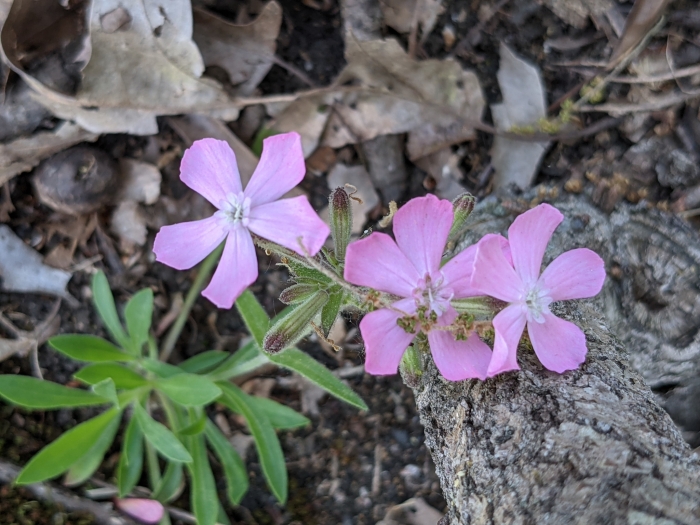Sticky Catchfly
(Silene caroliniana)
Sticky Catchfly (Silene caroliniana)
/
/

Laura J. Costello
CC BY 4.0
Image By:
Laura J. Costello
Recorded By:
Copyright:
CC BY 4.0
Copyright Notice:
Photo by: Laura J. Costello | License Type: CC BY 4.0 | License URL: http://creativecommons.org/licenses/by/4.0/ | Rights Holder: Laura J. Costello | Publisher: iNaturalist | Date Created: 2021-05-19T18:04:51-07:00 |


















































Estimated Native Range
Summary
Silene caroliniana, commonly known as Sticky Catchfly, is a semi-deciduous perennial herb native to open woodlands and rocky slopes in the Eastern United States. It typically grows to a height and width of 0.8-1 feet (0.2-0.3 meters), forming a low, mounding clump. The Sticky Catchfly is notable for its lance-shaped leaves and clusters of bright pink flowers that bloom in the spring, which are particularly attractive to a variety of pollinators, including large bees, bee flies, and hawkmoths. The flowers’ vivid color and extended bloom time make them a showy addition to garden settings.
Sticky Catchfly thrives in full sun to part shade and prefers well-drained soils. It is drought-tolerant once established, making it suitable for rock gardens, border fronts, and native plant gardens. Its low water requirements and ease of maintenance are beneficial for gardeners interested in water conservation. While it is adaptable to various soil types, it performs best in sandy or gravelly soils. In cultivation, it is valued for its spring floral display and its ability to attract beneficial pollinators. However, it is important to note that in Florida, Silene caroliniana is listed as an endangered species, indicating that it should be cultivated responsibly and with consideration for its conservation status.CC BY-SA 4.0
Sticky Catchfly thrives in full sun to part shade and prefers well-drained soils. It is drought-tolerant once established, making it suitable for rock gardens, border fronts, and native plant gardens. Its low water requirements and ease of maintenance are beneficial for gardeners interested in water conservation. While it is adaptable to various soil types, it performs best in sandy or gravelly soils. In cultivation, it is valued for its spring floral display and its ability to attract beneficial pollinators. However, it is important to note that in Florida, Silene caroliniana is listed as an endangered species, indicating that it should be cultivated responsibly and with consideration for its conservation status.CC BY-SA 4.0
Plant Description
- Plant Type: Herb
- Height: 0.8-1 feet
- Width: 0.8-1 feet
- Growth Rate: Moderate
- Flower Color: Pink, White
- Flowering Season: Spring
- Leaf Retention: Semi-Deciduous
Growth Requirements
- Sun: Full Sun, Part Shade
- Water: Low, Medium
- Drainage: Fast
Common Uses
Bee Garden, Bird Garden, Border Plant, Butterfly Garden, Drought Tolerant, Groundcover, Hummingbird Garden, Rock Garden, Showy Flowers
Natural Habitat
Open woodlands and rocky slopes
Other Names
Common Names: Wild Pink, Wild Campion
Scientific Names: , Silene caroliniana, Silene caroliniana var. caroliniana, Silene caroliniana subsp. typica,
GBIF Accepted Name: Silene caroliniana Walter